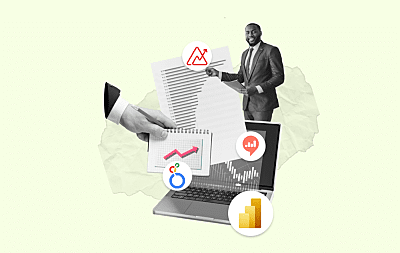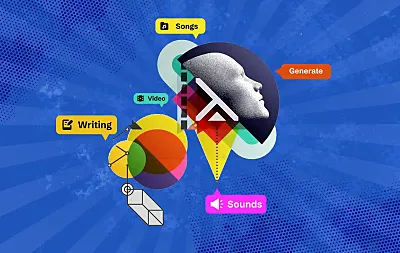“Data is the new gold,” is a marketing line by Salesforce. And, if you are an aspiring data analyst, data scientist, marketing analyst, or anyone who deals with data or wants to learn to deal with it, you must’ve heard this quote. But to uncover that gold, we need the best data analytics tools. Read More
14 Best Data Analytics Tools to Uncover Siloed Data in 2024!
Microsoft Power BI

Visit Microsoft Power BI:
About

Microsoft Power BI is a popular business intelligence and data visualization tool. Using this powerful tool, you can transform data from various sources into clear and insightful reports.
The tool is created for users with a range of technical skills. Contrarily, it does offer a user-friendly interface for creating interactive dashboards and reports.
It is among the big data analytics tools (with limited features) that are capable of connecting a wide range of data sources. Data that is available on-premise and in the cloud. This factor makes Power BI a versatile tool suitable for all sizes of businesses. By leveraging, the data analysis software, you can gain valuable insights from your data, identify trends & patterns, and even make data-driven decisions.
Why we picked it? 
Google Analytics

Visit Google Analytics:
About

Google Analytics is a free web analytics service developed by Google. It is often considered among mobile app analytics tools because of its capability to track mobile traffic data. Basically, the tool magnifies your digital efforts. For instance, it can track traffic, user behavior, conversions, and a lot more.
By adding a bit of code to this data analysis tool to your website, it can collect data on almost everything. This ranges from visitors to pages that they viewed and for how long. This data is then translated into insightful reports that help understand how people interact with your website.
So, whether you are a small business or a marketing manager, Google Analytics can prove to be valuable for your website’s effectiveness. Basically, it can help you achieve your online goals.
Why we picked it? 
Tableau

Visit Tableau:
About

Tableau is a powerful data analysis software. It can be used for data visualization and business intelligence. The tools allow its users to connect with different types of data sources. Furthermore, you can drag and drop data fields for a plethora of tasks. For instance, creating charts, graphs, and maps, and customizing them as per trends, patterns, and insights.
Tableau’s strength lies in its user-friendly interface. The tool makes it accessible to both technical and non-technical users for data exploration and communication. By creating interactive dashboards and reports, this tool for data analysts helps people understand data and make data-driven decisions.
Why we picked it? 
Qlik

Visit Qlik:
About

Qlik is another business analytics platform that empowers its users to explore and gain insights from data. Founded in the year 1993, it provides a suite of data analytics tools that includes Qlik Sense and Qlik Replicate.
It is one of the best data analytics tools for a user-friendly interface and associative data engine. This allows users to dynamically analyze data from various sources and even uncover hidden patterns in data. Overall, it caters to businesses that seek to transform raw data into knowledge and make data-driven decisions.
Why we picked it? 
Looker Studio

Visit Looker Studio:
About

The ability of this one of the top data analytics tools lies in its ability to connect with a wide range of data sources. Basically, it can connect spreadsheets to databases enabling marketing platforms and web analytics.
The tool also empowers its users to create interactive charts, graphs, and other visualizations. Helps you with insightful stories from your data. Also, you can easily share your reports and collaborate with others.
Overall, it is a great choice for individuals and teams that want to gain clear and actionable insights from their data.
Why we picked it? 
SAS Business Intelligence

Visit SAS Business Intelligence:
About

Want to unlock the power of data and use it to make smarter decisions? SAS Business Intelligence is the key to it. It is one of the best data analytics tools that goes beyond reporting raw numbers.
By providing features like data visualization, advanced analytics, and even AI, SAS Business Intelligence has the capacity to empower users at multiple levels of organization. The tools also act as predictive analytics software. It automates insights for users, thereby, helping them uncover hidden trends and patterns to get actionable insights.
With the newfound knowledge of SAS Business Intelligence, you can make data-driven decisions that optimize efficiency, improve performance, and propel you towards their strategic goals.
Why we picked it? 
SAP BusinessObjects

Visit SAP BusinessObjects:
About

SAP BusinessObjects is an incredible data analysis software that can help translate data into clear and actionable insights. This is among the data analytics tools that deliver a centralized suite that acts like one of those business intelligence software.
The tool delivers a powerful combination of data reporting, visualization, and sharing capabilities. As part of the SAP Business Technology Platform, it provides scalable on-premise solutions. It transforms your data into real-time insights that are accessible via any device, anywhere.
Overall, this is amongst the tools for data analytics that empower users across organizations to make informed decisions. Furthermore, it delivers greater autonomy while fostering a collaborative environment. The tools help share knowledge and drive better business outcomes.
Why we picked it? 
Sisense

Visit Sisense:
About

In the sea of growing data, making sense of everything can feel difficult. Sisense is amongst the top data analytics tools that can provide powerful business intelligence with a modern touch for a data-driven organization.
Forget clunky reports, the tool empowers everyone from tech-savvy analysts to executives. It lets you harness the potential of your data. The innovative platform leverages cutting-edge artificial intelligence and machine learning. The combination of these technologies transforms complex information into clear, interactive dashboards and reports.
Sisense presents a user-friendly format that allows you to uncover trends, identify patterns, and gain actionable intelligence at record speed. Furthermore, the tool seamlessly integrates with your existing applications making it a powerful and adaptable tool. With this one of the advanced data analytics tools, you can unlock many secrets hidden in your data to make informed decisions.
Why we picked it? 
RapidMiner

Visit RapidMiner:
About

RapidMiner is a one-stop shop for any data science expert. The platform is powerful and goes beyond simple data storage. This is amongst the top tools for data analytics that offers a user-friendly visual interface for data mining and machine learning tasks.
With RapidMiner, you don’t need coding skills. It empowers you to build data analysis workflows with a simple drag-and-drop approach. These features make it a perfect entry for beginners to get started. Contrarily, it offers a robust toolkit for experienced users. So, clean, transform, analyze, and visualize your data with the intuitive environment of RapidMiner.
Why we picked it? 
Zoho Analytics

Visit Zoho Analytics:
About

Zoho Analytics is a data hero. It delivers a user-friendly and comprehensive Business Intelligence (BI) platform. With this one of the best data analytics tools in the market, you can forget the need for complex coding or specialist data analysts.
The tool helps empower everyone regardless of their technical expertise. It transforms raw data into actionable insights. Also, the intuitive drag-and-drop interface imports data from a variety of sources be it your CRM, marketing campaigns, and even social media.
With its affordable pricing, it can also be considered one of the best data analytics tools for small businesses. Beyond this, you get a powerful suite of tools for data cleaning, analysis, and visualization. Overall, this tool can empower you to make informed decisions, improve business, and gain a competitive edge.
Why we picked it? 
Bag relevant views, higher downloads & real shares for your app
Data Analytics Tools - Suitable Industries!
Our data analytics tools list comprises tools that are suitable for all sorts of businesses, be they small or big. However, each tool shines in particular areas and industries. Figuring out those, we have created a table below for you to make an effective decision.
| Tool | Scalability | Data Source Connectivity | Visualization Capabilities | Self-Service Analytics | Advanced Analytics Features |
|---|---|---|---|---|---|
| Microsoft Power BI | Good | Excellent | Excellent | Good | Moderate |
| SAP BusinessObjects | Moderate | Good | Good | Moderate | Good |
| IBM Cognos | Moderate | Good | Good | Moderate | Good |
| Oracle Analytics Cloud | Good (with configuration) | Excellent | Excellent | Good | Good (integrations needed) |
| RapidMiner | Moderate | Good | Good | Moderate | Excellent |
How We Created the List of the Best Data Analytics Tools & Software?
To provide the best data analytics tools for our users, we underwent certain factors and came up with our criterion. Let’s extrapolate:
1. Understanding User Requirements
- Data Types: Professionals often struggle with analyzing structured and unstructured data. So, the list should have had tools that deal with both these types of data.
- Data Volume and Complexity: Factors like the amount of data, its simplicity and complexity, and advanced analytics techniques determined the list. Our data analytics tools list, therefore, comprises tools that are capable of providing the necessary scalability in terms of data.
- Analysis Goals: The tools selected should be capable of providing different kinds of insights. For example, descriptive statistics, trends, forecasting, or machine learning.
2. Technical Considerations
- User Skills: Different data analysts have different levels of technical expertise. So, the data analytics tools added should cater to both advanced users as well as beginners.
- Data Integration: We considered the integration capability of the tools with different data sources, for example, databases, cloud storage, etc.
- Scalability: Are the tools capable of handling your current and future data volumes?
3. Other Important Factors:
- Security and Compliance: We considered that the security of the tool does meet the required data privacy and regulatory compliance needs.
- Cost: Keeping in mind the licensing fees, training costs, and ongoing maintenance, we considered the limitations and features provided by these data analytics software tools.
- Vendor Support: Is the customer support responsive and helpful? Is documentation good enough?
By considering each of these factors, we were able to create our data analytics tools list. Basically, we tried to cater to general as well as some specific needs. This helped us create a list that is ideal for both beginners and advanced users.
Common Types of Data Analytics Tools
Data analytics tools come in various types. Each of these types can sort different tasks within the data analysis workflow. So, here’s a breakdown of some common types:
1. Data Wrangling and Transformation Tools:
- These data analytics tools clean, prepare, and transform raw data into usable formats for analysis.
- Examples: OpenRefine, Trifacta Wrangler, and Python libraries like Pandas.
2. Data Visualization Tools:
- These are data and analytics tools that help create charts, graphs, and other visual representations of your data to communicate insights effectively.
- Examples: Tableau, Power BI, QlikView, and Google Data Studio (Looker Studio).
3. Statistical Analysis Tools:
- These tools for data analytics allow you to perform statistical analyses on your data. For example, calculating means, medians, correlations, and conducting hypothesis tests.
- Examples: R, SAS, Python libraries like SciPy and Statsmodels.
4. Programming Languages:
- While, these are not strictly tools, programming languages like Python and R offer powerful libraries and frameworks. These can be utilized for data analysis, data manipulation, and complex modeling.
- These languages provide a lot of flexibility and customization but, they require programming knowledge.
5. Business Intelligence (BI) Tools:
- These are comprehensive platforms. They combine data visualization, data warehousing, reporting, and sometimes even basic analytics capabilities.
- These are often targeted towards business users and provide user-friendly interfaces for data exploration and creating reports.
- Examples: Microsoft Power BI, Qlik Sense, SAP BusinessObjects.
6. Machine Learning and Artificial Intelligence (AI) Tools:
- These tools for data analysis allow you to build and train machine learning models for tasks like classification, prediction, and anomaly detection.
- Some data visualization and BI tools incorporate basic learning functionalities.
- Examples: TensorFlow, Scikit-learn (Python library), RapidMiner, etc.
7. Data Warehousing and Data Lake Tools:
- These are not analytical tools themselves. However, they play a crucial role in storing and managing large datasets for analysis.
- Data warehouses store structured data for querying and reporting. Contrarily, data lakes store both structured and unstructured data for broader exploration.
- Examples: Amazon Redshift, Microsoft Azure Synapse Analytics, and Google BigQuery.
Top Data Analytics Tools - Pitting the Contender Against Each Other!
To better understand the best data analysis tools, we identified the top 5 tools and compared them against each other. Here’s the table:
| Tool | Scalability | Data Source Connectivity | Visualization Capabilities | Self-Service Analytics | Advanced Analytics Features |
|---|---|---|---|---|---|
| Microsoft Power BI | Good | Excellent | Excellent | Good | Moderate |
| SAP BusinessObjects | Moderate | Good | Good | Moderate | Good |
| IBM Cognos | Moderate | Good | Good | Moderate | Good |
| Oracle Analytics Cloud | Good (with configuration) | Excellent | Excellent | Good | Good (integrations needed) |
| RapidMiner | Moderate | Good | Good | Moderate | Excellent |
Explanation:
- Microsoft Power BI: It delivers powerful and user-friendly features. However, scalability can be a big issue for extremely large datasets.
- SAP BusinessObjects: It is an established platform with good capabilities across all areas. However, scalability for big data might be limited.
- IBM Cognos: Another established BI platform with good functionality, but again, scalability for big data is a concern.
- Oracle Analytics Cloud: The tool delivers strong data handling and visualization. However, advanced analytics might require additional configuration or integration with tools.
- RapidMiner: It is not suitable for big data analysis, much like other tools. However, it excels in data mining and machine learning tasks.
Remember, this table of tools for data analysts is simply a starting point. You need to consider your own specific needs and priorities to evaluate tools that are suitable for you.
Conclusion
The importance of having the best data analytics tools at your disposal is no hidden truth. Our intent with this list was to help you find a relevant tool that can integrate easily with your cloud storage and in-house databases.
These tools can help you find insights that can help you tackle the current competition in the market and entice new customers. With us saying this, we hope that this list may have provided you with some relevant top data analytics tools as options. Options that will help you maximize efforts for your niche and use case.
Also, on an ending note, do you have a data analytics tool or any digital product that can help people? If yes, get your product listed. At MobileAppDaily, we create listicles for the best digital products in different categories. Products in these listicles are placed on relevant rankings. Being a part of this ecosystem can help you with getting new customers, branding, and more credibility in the market. So, don’t wait, and become a part of MAD (MobileAppDaily).
With our strategically designed marketing solutions












